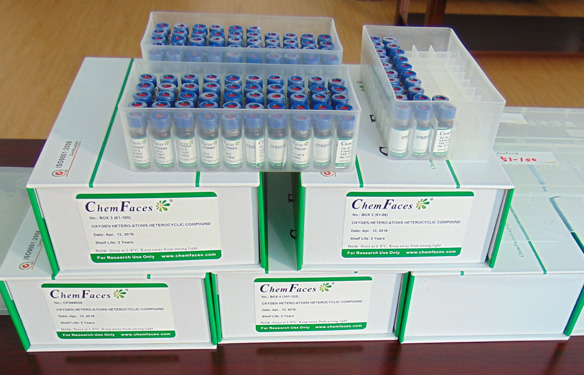Linalyl acetate
Linalyl acetate, the main component of lavender oil is commonly used as a fragrance chemical in scented products. Linalyl acetate relaxes vascular smooth muscle through dephosphorylaton of myosin light chain. Linalyl acetate has genotoxicity.
Inquire / Order:
manager@chemfaces.com
Technical Inquiries:
service@chemfaces.com
Tel:
+86-27-84237783
Fax:
+86-27-84254680
Address:
1 Building, No. 83, CheCheng Rd., Wuhan Economic and Technological Development Zone, Wuhan, Hubei 430056, PRC
Providing storage is as stated on the product vial and the vial is kept tightly sealed, the product can be stored for up to
24 months(2-8C).
Wherever possible, you should prepare and use solutions on the same day. However, if you need to make up stock solutions in advance, we recommend that you store the solution as aliquots in tightly sealed vials at -20C. Generally, these will be useable for up to two weeks. Before use, and prior to opening the vial we recommend that you allow your product to equilibrate to room temperature for at least 1 hour.
Need more advice on solubility, usage and handling? Please email to: service@chemfaces.com
The packaging of the product may have turned upside down during transportation, resulting in the natural compounds adhering to the neck or cap of the vial. take the vial out of its packaging and gently shake to let the compounds fall to the bottom of the vial. for liquid products, centrifuge at 200-500 RPM to gather the liquid at the bottom of the vial. try to avoid loss or contamination during handling.
Nutrients.2018, 11(1):E17
Front Pharmacol.2021, 12:690113.
Metabolites.2023, 13(6):689.
Naunyn Schmiedebergs Arch Pharmacol.2017, 390(10):1073-1083
J Physiol Biochem.2024, 80(2):421-437.
Mol Immunol. 2016, 78:121-132
J Agric Food Chem.2024, 72(42):23183-23195
Industrial Crops and Products2022, 188:115638
Antiviral Res.2021, 193:105142.
J Ethnopharmacol.2022, 291:115159.
Related and Featured Products
Contact Dermatitis, 2010, 58(1):9-14.
Autoxidation of linalyl acetate, the main component of lavender oil, creates potent contact allergens.[Pubmed:
18154552]
Fragrances are among the most common causes of allergic contact dermatitis. We have in previous studies shown that linalool, present in lavender oil, autoxidizes on air exposure, forming allergenic oxidation products. Oxidized linalool was found to be a frequent cause of contact allergy in a patch test study on consecutive dermatitis patients. Linalyl acetate, the main component of lavender oil is commonly used as a fragrance chemical in scented products. Because of structural similarities, Linalyl acetate should also be susceptible to oxidation on air exposure, forming similar oxidation products as linalool.The aim of the present study was to investigate the autoxidation of Linalyl acetate and the influence of oxidation on its sensitizing potency.
METHODS AND RESULTS:
Analyses were performed using gas chromatography, nuclear magnetic resonance spectrometry and mass spectrometry. Sensitizing potencies of compounds were determined using the local lymph node assay (LLNA) in mice. Analyses showed that the content of Linalyl acetate decreased over time on air exposure and other compounds were formed. Hydroperoxides, an epoxide and an alcohol were identified as oxidation products from Linalyl acetate. In the LLNA, Linalyl acetate of high purity showed a weak sensitizing potency (EC3 25%). Autoxidation increased the sensitizing potency of Linalyl acetate, and a 10 weeks oxidized sample gave an EC3 value of 3.6%. As for linalool, the hydroperoxides were shown to be the oxidation products with the highest sensitizing potency.
CONCLUSIONS:
It is concluded that autoxidation of the weakly allergenic Linalyl acetate leads to formation of allergenic oxidation products.
International Congress of Pharmacology. 2006.
Linalyl acetate as a major ingredient of lavender essential oil (LEO) relaxes vascular smooth muscle through dephosphorylaton of myosin light chain.[Reference:
WebLink]
Aromatherapy is widely known as an alternative treatment with essential oils. Amongthem,LEO has been reported to be effective for hypertension and atherosclerosis. Thus,the present experiments were designed to investigate whether Linalyl acetate (LA) as a major ingredient of LEO relaxes vascular smooth muscle, if so to analyze the mechanisms.
METHODS AND RESULTS:
Transverse strips of rabbit carotid arteries were used for isometric tension measurements and Western blotting to assess the phosphorylation ratio of myosin light chain (MLC). LA exerted a sustained and progressive relaxation during the contraction caused by phenylep hrine. Pharmacological analyses revealed that relaxation with LA was resulted from partially activating endothel ial NO - cyclic GMP pathway and partially reducing the MLC phosphorylation ratio in smooth muscle layer. The red uced MLC phosphrylation ratio and relaxation with LA were reversed by calyculin A as an inhibitor of MLC phosphatase. but remained unaffected by ML9 as an inhibitor of MLC kinase,suggesting the possible involve ment of activation of MLC phosphatase in causing relaxation with LA.
CONCLUSIONS:
Taken together,our results seem to be providing a new possibility on approach for vascular diseases.
Fitoterapia, 2013, 89(1):48-57.
Implication of limonene and linalyl acetate in cytotoxicity induced by bergamot essential oil in human neuroblastoma cells.[Pubmed:
23707744]
Bergamot (Citrus bergamia, Risso et Poiteau) essential oil (BEO) is a widely used plant extract showing anxiolytic, analgesic and neuroprotective effects in rodents; also, BEO activates multiple death pathways in cancer cells. Despite detailed knowledge of its chemical composition, the constituent/s responsible for these pharmacological activities remain largely unknown. Aim of the present study was to identify the components of BEO implicated in cell death.
METHODS AND RESULTS:
To this end, limonene, Linalyl acetate, linalool, γ-terpinene, β-pinene and bergapten were individually tested in human SH-SY5Y neuroblastoma cultures at concentrations comparable with those found in cytotoxic dilutions of BEO. None of the tested compounds elicited cell death. However, significant cytotoxicity was observed when cells were cotreated with limonene and Linalyl acetate whereas no other associations were effective. Only cotreatment, but not the single exposure to limonene and Linalyl acetate, replicated distinctive morphological and biochemical changes induced by BEO, including caspase-3 activation, PARP cleavage, DNA fragmentation, cell shrinkage, cytoskeletal alterations, together with necrotic and apoptotic cell death.
CONCLUSIONS:
Collectively, our findings suggest a major role for a combined action of these monoterpenes in cancer cell death induced by BEO.



